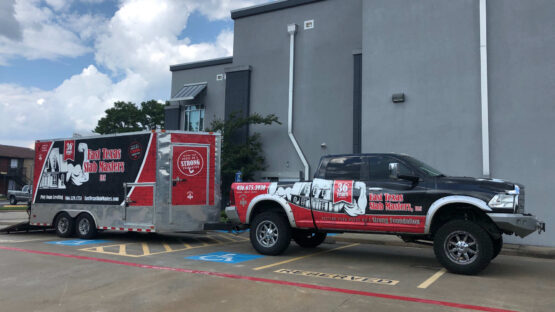Our Foundational Crack Repair Methods
Whether you’ve got cracks in your slab, your windows or doors stick, or any of the other typical warning signs, one of East Texas Slab Master’s experts will determine which repair method should be utilized to restore your property appropriately.

In East Texas, foundation issues are a common problem. The clay soil swells and contracts between rainy and drought cycles, and new homes settle into the soil over time. But if your foundation continues to shift, it may be time for reinforcement from professional foundation repair experts. Start by learning more about the most common foundation repair methods and what they each do best. Then, call in the experts from East Texas Slab Masters for a no-obligation foundation assessment.
Polymers
Often, foundation damage is caused by loose or turbulent topsoil—the first few feet of dirt under your home shrink and contract too much to provide a reliable surface for the whole home’s weight to rest on. Professional foundation repair services can correct this by adding a geopolymer chemical to the soil. It’s a high-density substance that, once injections at fixed points under your home, adds more stability to the soil. This option is long-lasting and much less disruptive than breaking into the foundation or driving piers into the ground.
Pier Pilings
Pier pilings are common types of foundation repair services for interior and exterior foundation problems in both pier-and-beam and slab foundation homes. To add stability and resistance, contractors will drive pressed concrete piers about 12 feet deep into the soil at key points around your home’s foundation. The pilings are six-inch wide concrete cylinders pressed into place by a hydraulic machine. The foundation can rest its weight on the piers rather than just the soil. Not only does this add more structural control, but the piers are deep enough to rest on more stable ground below the top several feet of dirt, such as bedrock.
Drilled Bell Bottom Piers
Bell bottom piers, or belled piers, have a distinct belled shape, with the bottom being much wider than the middle and top. The unique foot shape gives the pier more stability because of the increased bottom surface area. Contractors can make belled piers by drilling into the soil, excavating a wider hole at the bottom of the cavity, and then pouring in concrete. For added structural support, most drilled bell bottom piers also have a steel rod running through the center.
Moisture Containment Barriers
A moisture containment barrier is a preventive option but can also be added after the fact. It consists of sheets of specialty plastic that wrap vertically around the foundation (and some distance past its bottom edge) to prevent groundwater from getting under it too quickly and destabilizing it. This is ideal for homes vulnerable to sudden groundwater surges due to heavy storms. It is different from a vapor barrier, which sits under the foundation to protect the concrete from moisture exposure.
Retaining Wall
It’s not just underground soil movement that can jeopardize your foundation. Hilly ground and erosion can also put your foundation at risk of breakage and severe shifting. If your home is near a creek or steep slope, a professionally designed and constructed retaining wall can hold the soil in place around that edge of your foundation.
East Texas Slab Masters: Your Foundation Repair Experts
If you notice signs of settling or ongoing foundation damage, don’t wait. Call professional foundation repair experts to assess the damage and recommend the right solutions for your soil, property, and foundation risks. At East Texas Slab Masters, we specialize in several different solutions and foundation repair methods so we can provide the right ones for your unique property. Contact us today to learn more or to schedule your no-obligation assessment.

